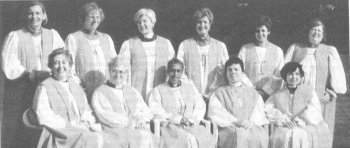
|
Lunch with the Women Bishops!
 One Monday in July I found myself having lunch in a small room at
the Lambeth Conference with about thirty women priests and nine women bishops. Being in a
large group of women priests is by now a very normal happening; to be with a number of
women bishops was a rare opportunity, not likely to occur again in this country for some
time. I was only there because someone else could not be, and I am very grateful to Canon
Valerie Rampton for this exciting opportunity. The Adviser in Women’s Ministry from
each of the English Dioceses had been invited to the lunch and when Valerie, our Southwell
representative, found she couldn’t go, she asked me to take her place.
One Monday in July I found myself having lunch in a small room at
the Lambeth Conference with about thirty women priests and nine women bishops. Being in a
large group of women priests is by now a very normal happening; to be with a number of
women bishops was a rare opportunity, not likely to occur again in this country for some
time. I was only there because someone else could not be, and I am very grateful to Canon
Valerie Rampton for this exciting opportunity. The Adviser in Women’s Ministry from
each of the English Dioceses had been invited to the lunch and when Valerie, our Southwell
representative, found she couldn’t go, she asked me to take her place.
It was a very informal affair, and I did not come back armed with lots of facts and figures or even theological arguments in favour of women being bishops, just with a host of very favourable impressions and feelings. There are now eleven female bishops within the Anglican Communion - eight from the USA, two from Canada and one from New Zealand - six are Diocesans, five Suffragans. Nine of these were able to be present at the lunch.
The first, and continuing, impression was of their openness and approachability. This is not meant to infer anything about male bishops! All of the male bishops whom I know well are extremely approachable and human individually, but as a group they can seem quite intimidating. The women obviously got on with each other very well, were thoroughly enjoying the support they were able to give each other at Lambeth, instead of being dotted around the earth thousands of miles apart, and were eager to warmly encourage us as a newer generation of women priests by relating their own experiences with enormous honesty.
The second impression was of their courage, strength and holiness. These were very spiritual people. And they needed to be, for their task is not an easy one. Women priests (like women doctors, lawyers managers… before them) are very aware of the expectations put on them to ‘get it right’ on behalf of their whole sex. For women bishops, with their hugely larger responsibilities, the expectations and stresses and hopes laid on them are enormous. One of them said that the only way through was to follow three imperatives:
- to love and trust God
- to care for the people
- and to have fun
All of those we met sounded as though they lived with this as their guiding rule.
It is nine years since the Rt. Revd. Barbara Harris was consecrated Suffragan Bishop of Massachusetts, the first woman bishop. The press at the time delighted in pointing out that she was black, divorced and an East Coast liberal, just the sort of appointment that you would expect the radical, politically correct religious establishment of the U.S. to make. In the flesh Bishop Barbara is a tiny frail woman who travels around in a wheelchair, the robustness of her faith and her sense of humour seem at odds with her person; she is anything but a stereotype. She spoke of her consecration in 1989 when the police advised her to wear a bullet-proof vest, in case ‘traditional Christians’ in the congregation assaulted her. She refused, because "I would have fallen over with the weight… and anyway it would be a marvellous way to go!"
The other American bishops could not speak highly enough of Bishop Barbara’s pioneering role, her example and her support and encouragement to each of them as their turn came. Most of the women bishops now are not from urban, liberal dioceses. They come from places like Maine and Indianapolis, described as being "very traditional and homey" parts of the Episcopal Church in the USA. In these very ordinary and conservative areas church members have voted women to be their bishops, for in the US, Canada and New Zealand, bishops are elected, not appointed. They have confidence that God is calling women to this ministry, and looking round can have confidence in those already in the Episcopal role. They are an impressive bunch.
Return to the Articles contents page
http://www.stpetersnottingham.org/misc/womenbishops.htm
© St Peter's Church, Nottingham
Last revised 30th August 1998